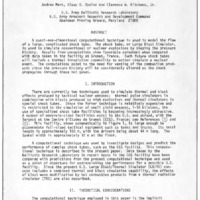-
Title
-
Design Of Blast Simulators For Nuclear Testing
-
Report Number
-
CONF-8305107, p. 243-248
-
Creator
-
Mark, Andrew
-
Opalka, Klaus O.
-
Kitchens, Clarence W. ,Jr.
-
Corporate Author
-
U.S. Army Ballistic Research Laboratory, U.S. Army Armament Research and Development Command
-
Laboratory
-
Lawrence Livermore National Laboratory
-
Date
-
1983
-
Date Issued
-
1983-07
-
Extent
-
6
-
Identifier
-
ADA132780
-
Format
-
1 online resource (6 pages : ill.)
-
Abstract
-
A quasi-one-dimensional computational technique is used to model the flow of a large, complicated shock tube. The shock tube, or Large Blast Simulator, is used to simulate conventional or nuclear explosions by shaping the pressure history. Results from computations show favorable aqreement when compared with data taken in the facility at Gramat, France. Such future shock tubes will include a thermal irradiation capability to better simulate a nuclear event. The computations point to the need for venting of the combustion products since the pressure history will be considerably altered as the shock propagates through these hot gases.
-
Description
-
A quasi-one-dimensional computational technique is used to model the flow of a large, complicated shock tube. The shock tube, or Large Blast Simulator, is used to simulate conventional or nuclear explosions by shaping the pressure history. Results from computations show favorable aqreement when compared with data taken in the facility at Gramat, France. Such future shock tubes will include a thermal irradiation capability to better simulate a nuclear event. The computations point to the need for venting of the combustion products since the pressure history will be considerably altered as the shock propagates through these hot gases.
-
Distribution Classification
-
1
-
Distribution Conflict
-
No
-
DTIC Record Exists
-
No
-
Illinois Tech Related
-
No
-
Photo Quality
-
Not Needed
-
Report Availability
-
Full text available
-
Type
-
article
 article31
article31